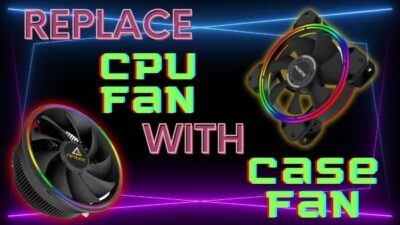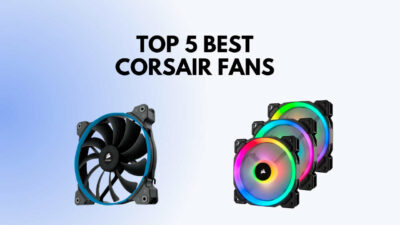When building a powerful or gaming PC, one crucial aspect often overlooked is the number and configuration of fans.
Adequate and sufficient cooling is necessary to maintain ideal performance and prevent damage from excessive overheating. But one question remains for beginners and PC enthusiasts: how many fans should they use for better cooling?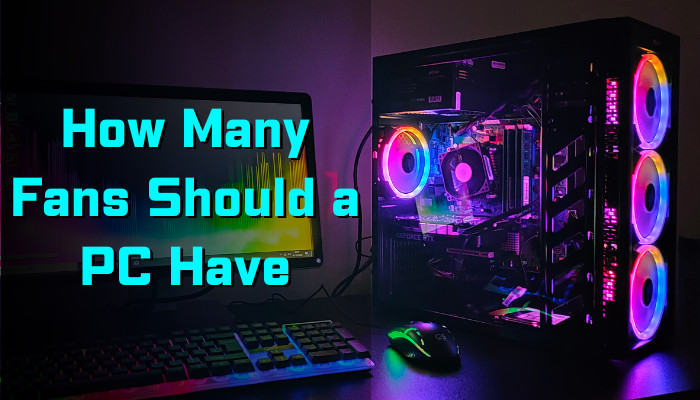
To solve the mystery, I’ll describe the fan airflow management and the required fans for improving your cooling performance in this article.
So, let’s begin.
How Does the Airflow Work on a PC?
The airflow in a PC refers to the air movement inside the computer case to dissipate the heat generated by the PC components and maintain optimal operating temperature. The air circulates through the PC fans and exits from the other side, taking the hot air out of the PC.
Proper airflow is crucial to prevent overheating and ensure the parts’ safety and longevity. The air passes linearly and mainly works in front-to-back and bottom-to-top directions to provide the best CPU air cooling to the CPU coolers.
Fan Size
When it comes to PC fan dimensions—size matters. Most PC cases come with one or multiple pre-installed fans. But to give the best cooling performance, they aren’t sufficient enough.
There is a wide range of fan sizes, and you’ll need to choose the suitable one for fulfilling your specific cooling target. The fan comes in various dimensions, ranging from 40mm to 200m.
80mm, 120mm, 140mm, and 200mm are the most common PC case fan sizes. The fan size determines the cooling capacity by providing airflow or static pressure.
Among all the fans, the 120mm fan is the most common and widely used in various sizes of cases. Depending on your case requirements, you should choose the right fitting fan and set them as intake or exhaust.
Intake Vs. Exhaust Fans
When the air goes in a single direction, there should be an entry and exit, right? That’s what the intake and exhaust fan does. Every PC has an intake and exhaust area, and based on that, the type of air cooler is determined.
Intake Fans: The intake fans are typically located at the front and side. It pulls the cool air from outside and passes inside the computer case. Multiple intake fans can be placed to create positive pressure in a case. 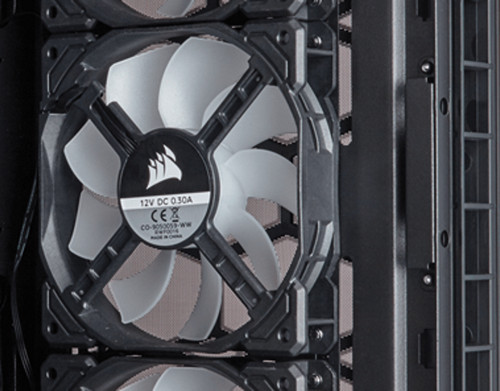
Exhaust Fans: The exhaust fans are generally placed at the rear and top of the PC case. It expels the hot air created by the components and prevents overheating. Using the exhaust fans, you can create a negative pressure and keep the PC cool. 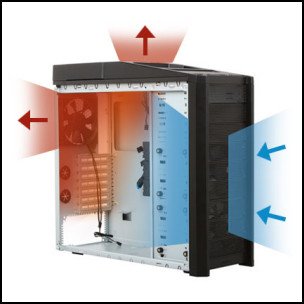
The fans will spin with their maximum capacity, but most importantly, you’ll need to set up a proper airflow direction and place your components perfectly to ensure the best air circulation.
Fan Arrangements
Choosing the right fan size and placing them as intake or exhaust isn’t enough to provide the best cooling performance. You’ll need the correct fan arrangement to circulate the cool air inside and emit the hot from the other side.
The case fans generally sit at the front, rear, top, bottom, and one or multiple fans at each side. Based on the positioning, there are multiple fan arrangement techniques, and the below passage will describe the most used and effective placement of your case fans.
Front, Rear, Top, and Bottom Configuration: An ideal fan arrangement that draws a lot of cool air inside and has a direct path to emit the hot air.
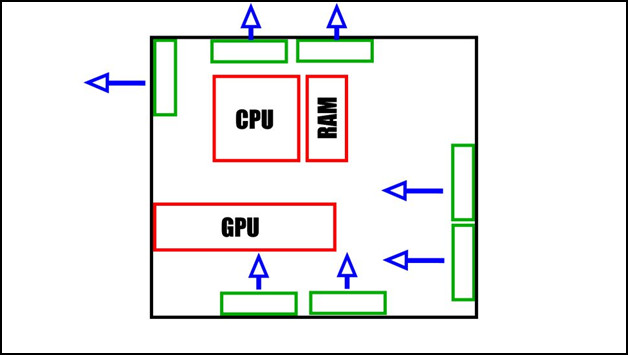
The above fan arrangement can create lots of positive and negative pressure and cool down the PC component in the most common way.
Front, Rear, and Bottom Configuration: The exhaust relies on a single fan at the rear with this fan arrangement. It creates a heavy positive pressure inside, which is a good sign, but it can be tricky to reduce the temperature when it gets too hot.
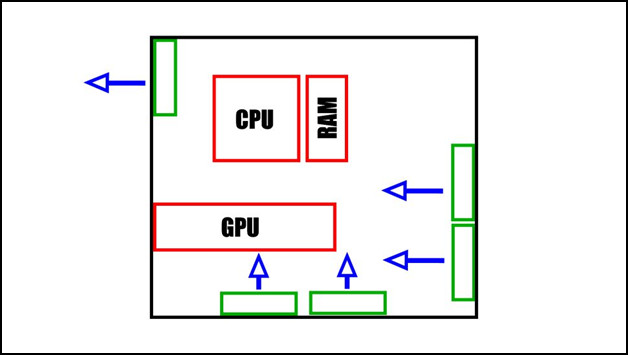
Front and Rear Configuration: It’s another common fan configuration, mostly used in entry-level PC and pre-configured cases. The front usually consists of two fans creating positive pressure and one rear creating negative pressure.
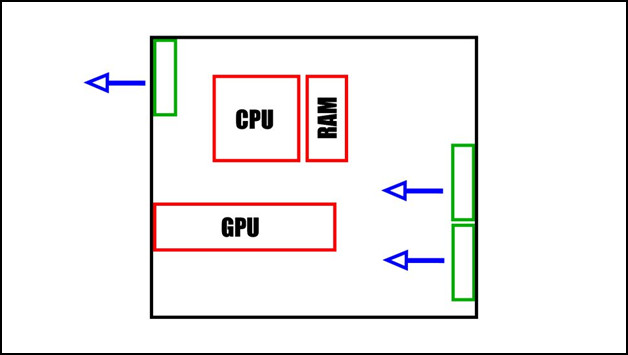
If you have a low-budget build, you can go with this arrangement. But for the high-end configuration, you should choose a better one.
Front, Rear, and Top Configuration: The front, rear, and top fan arrangement create lots of negative pressure, which can be less effective than the front, rear, and bottom configuration.
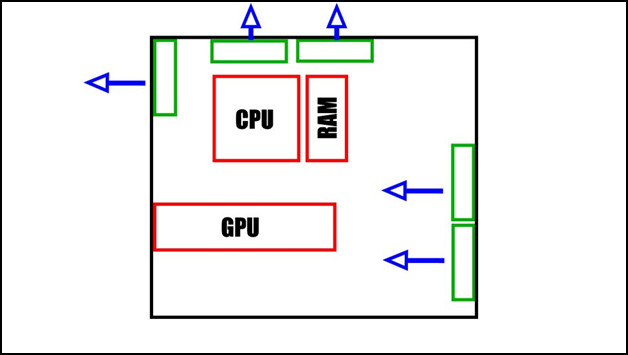
But this configuration can benefit your PC if you have a sound air circulation system at the front.
Top and Bottom Configuration: The chimney configuration is opposite to the front-rear configuration. It creates a straight entry and exit from bottom to top.

This configuration isn’t suitable for most PC arrangements. But it can give better results if you have a vertically mounted graphics card.
Rear Fan Only: The single rear fan setup solely emits the hot air from the PC. It’s suitable for the low configuration PC, which doesn’t require much cooling performance.
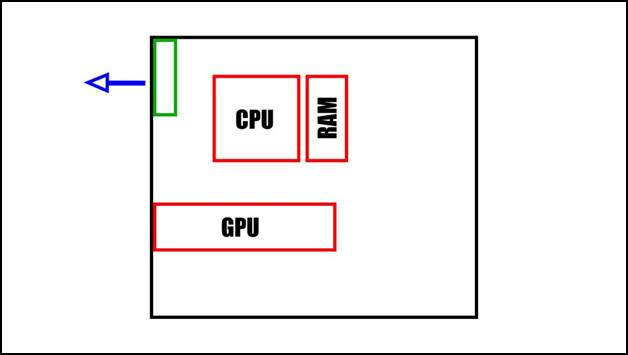
If you have a cheap component or work in a very cool temperature, the rear-only fan arrangement can do the work.
I guess you’ve already decided which fan configuration you want to go with!
But which types of fan are you choosing on your PC? Does your case have enough room, or is it very congested with the components?
Well, there’s nothing to get confused about. Depending on the casing space and cooling requirements, you must choose different fans for the best performance. Read the following passage to learn the ideal fans for your PC case.
What Types of Fan Do You Need For Better Airflow?
The type of fan required in a computer depends on your PC setup. Generally, a computer needs a fan to cool the component, CPU, or GPU. Based on the casing size and free space, you must choose between airflow or static pressure fans to provide optimal cooling.
The airflow and static pressure fans are different in size and are made to serve different purposes. They are used to cooling down different components, and the following passages will provide all the information you need to choose the perfect fans regarding your PC requirements.
Airflow Fans
Airflow fans, also known as high-volume fans, are designed to move a larger air volume with lower resistance. It is usually measured in Cubic Feet per Minute (CFM) or cubic meters per minute (m³/min).
These fans are most effective when the air needs to be circulated in an open space, such as PC cases with unobstructed airflow.
The 200mm fan is an excellent example of an airflow fan. They are used as intake and exhaust fans to create massive positive or negative pressure. It provides general air circulation to the PC and cools down components like RAM, GPU, and storage drives.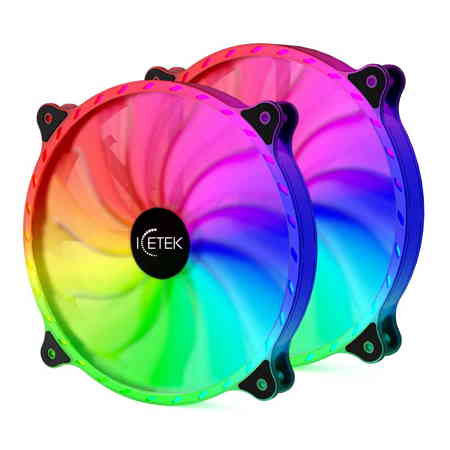
The airflow fans are generally quiet, have large fins, and are perfect for ATX and E-ATX PC cases. If you have a computer with such a casing, airflow fans would be perfect.
As we are talking about casing with significant heat dissipation ability, let’s check some of the best airflow casing for your PC.
Static Pressure Fans
The static pressure fans are designed to overcome resistance and push air through obstructed areas. It’s perfect for places where linear air movement can’t reach, such as CPU coolers, heatsinks, or radiators.
These fans are generally smaller in size and have different dimensions. 80mm, 90mm, and 120mm fans come in the static pressure category. They run at a high RPM and move the air rather than volume to cool down the dense components.
Due to running at greater speed and dense fin architecture, the static pressure fans are loud and create a bit of noise compared to airflow fans.
The static pressure fans are suitable for SFF (Small Form Factor) PCs with HTPC, mini-ATX, and I-ATX casing. If you’ve such a PC setup, using the static pressure fans will dissipate the hot air and keep your PC components cool.
According to your current PC configuration, or if you’re building a new one, choose the airflow or static pressure fans and make a good air circulation system.
How Many Fans Does Your PC Need?
The number of fans required for a computer depends on the PC’s components, cooling requirements, and the desired level of performance. Usually, a PC needs at least three fans—two intakes and one exhaust. But it may change considering the PC’s size and providing adequate airflow.
I’ve already described the types of fans, airflow, and static pressure fans above. It will give you a basic idea of what fan to start with.
But before checking our tested result and fan requirements, it’s utterly necessary to know about a fan’s CFM, dB, and RPM. Because, these factors are crucial and can help you pick the right fan that can provide optimal cooling and maintain a low noise level.
CFM: Cubic Feet per Minute (CFM) measures a fan’s airflow capacity, which represents the volume of air a fan can move in a minute. It demonstrates how effectively a fan can circulate air within a specific period.
A higher CFM value indicates a greater amount of air being moved by the fan, which can contribute to better cooling performance. A 70+ CFM will be a good starting point when choosing a fan.
But besides CFM, you’ll also need to consider the RPM and dB. And evaluating all the output, 50 CFM is the sweetest spot, maintaining optimal cooling performance, RPM, and noise level.
Noise Level (dB): Sound level is crucial when choosing a fan for your PC. Depending on the workload and required cooling performance, a fan can go from 30 to 70 dB.
30 dB is a pretty good sound level for a fan, whereas 70 is very loud. That’s why you should buy the best CPU cooler to maintain noise level resilience.
RPM: Revolutions per Minute or RPM indicates the speed at which the fan’s blades rotate. For the fan, a higher RPM refers to better airflow but also generates more noise.
It’s directly connected to the fan’s ability and cooling performance. Buying a higher RPM fan is necessary when you have an excellent PC and require much airflow to keep it cool.
Coming to the test part, we’ve used several fan setups, configurations, and CPU coolers and measured the CPU and GPU temperatures at different instances.
Test Bench
CPU: Intel i7-13700K | GPU: RTX 4080 | CPU Cooler: Noctua NH-D12L | Ambient Temperature: 22 °C
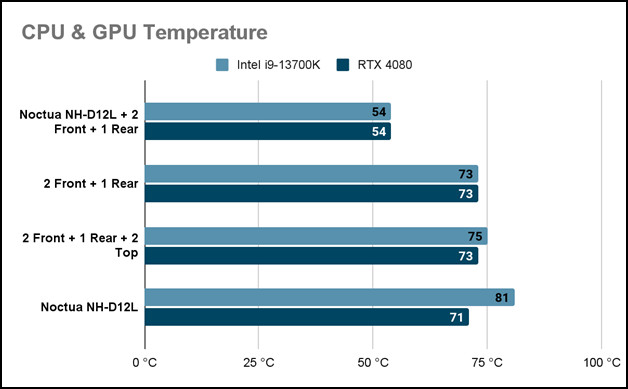
In our test, we used an ATX casing and measured the temperature with intake and exhaust fans in different positions. The best result we got was when using two intakes, one exhaust, and paired with the NH-D12L.
And the poor temperature we’ve received when using only the CPU cooler, as the air circulation wasn’t enough to dissipate the hot air.
We got The most optimal temperature, or the middle point when using the two front intakes and one rear exhaust in the casing.
We’ve also tested by adding two top exhausts, but the result wasn’t satisfying. The top exhaust was picking up the hot temperature from the GPU, and the CPU was getting warmer. As a result, the GPU stayed at the same temperature, but the temperature in 13700K had risen by 2 °C.
After doing more extensive tests with different stock fans and CPU coolers with various PC casings, we’ve found the best numbers of fans a PC should have to provide the best cooling performance.
These fan numbers are determined by keeping the temperature at bay, maintaining good noise levels, and providing the best RPM or cooling performance.
Here are the ideal numbers of fans your PC should have:
| Case Type | Required Case Fans |
|---|---|
| Small Form Factor (SFF) | 1-2 |
| Mini-Tower | 2-3 |
| Mid-Tower | 4-5 |
| Full-Tower | 5-8 |
Fans at separate settings will have a difference of a couple of degrees. The best practice is to use the front intake and rear exhaust for better performance. And if you can use an air cooler, it’s a plus point for your PC.
Frequently Asked Questions
How many fans does a good PC have?
A good PC generally has three fans. Two fans stay at the front as intake, and one at the rear as exhaust.
Are eight fans on a PC too much?
Eight PC case fans are required for extreme cooling performance. Most PCs contain three to five coolers, but the high-ends may need five to eight fans, depending on size and components.
Will more fans make my PC quieter?
The noise from the fan depends on the size. Larger fans are quieter but only good for the airflow. Installing more fans will increase airflow by providing better cooling performance and minimizing noise.
Conclusion
Sufficient fans are necessary to improve the cooling ability and maintain performance. If you provide fewer fans than required, the PC will overheat. And if more fans are installed than required, you won’t get any additional benefit.
The number varies from three to eight based on your PC configuration and the cooling performance you desire.
This article has provided all the information and the required number of fans for your PC to maintain a decent cooling facility.
I hope you’ve found the details informative and use them to build your next PC.
Cheers!



